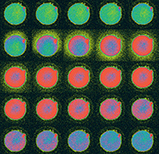
 |
Seven years ago Teresa Woodruff ’89 PhD and her husband, chemistry professor Tom O’Halloran, were taking their usual 6 a.m. walk along Lake Michigan near their Rogers Park home. He casually asked her why sperm contains so much zinc. That musing led to a lab experiment with grad student Alison Kim ’10 PhD that revealed for the first time that a fertilized egg releases an explosion of zinc at the moment when the sperm makes contact with the egg. “It’s a fundamental mechanism no one knew before,” says Woodruff. “No one even thought to look!”
 Bigger sparks seem to indicate better quality embryos. So someday doctors might be able to use a noninvasive zinc test to choose the best eggs to transfer during in vitro fertilization. With Francesca Duncan, the executive director of the Center for Reproductive Science, and colleagues and using funds from Ferring Pharmaceuticals (because human egg activation studies are not allowed with federal funds), she and the team have shown zinc sparks occur in humans. (Read more on the zinc spark research.)
Bigger sparks seem to indicate better quality embryos. So someday doctors might be able to use a noninvasive zinc test to choose the best eggs to transfer during in vitro fertilization. With Francesca Duncan, the executive director of the Center for Reproductive Science, and colleagues and using funds from Ferring Pharmaceuticals (because human egg activation studies are not allowed with federal funds), she and the team have shown zinc sparks occur in humans. (Read more on the zinc spark research.)
“This is the first experiment that shows that the zinc spark intensity, the amount of zinc released, might correlate with embryo quality,” says O’Halloran. “We hope that it will increase the well-being of the offspring from people who go through in vitro fertilization, because we think that this might give them the opportunity to only implant a single embryo. The morbidity and mortality in multiple births is significantly greater.”
Discover Magazine noted the zinc spark as “a major moment in the history of assisted human reproduction” and will highlight the discovery of the zinc spark as one of the top 100 science stories of 2016.
During their 12-year marriage, Woodruff and O’Halloran have maintained another kind of spark — a romantic one — through trips to the Chicago Symphony Orchestra (she grew up playing cello) and to Chicago Cubs games (she is a huge fan). “She knows more about baseball than nine out of 10 guys I know,” says O’Halloran. — K.S.
Tell us what you think. E-mail comments or questions to the editors at letters@northwestern.edu.